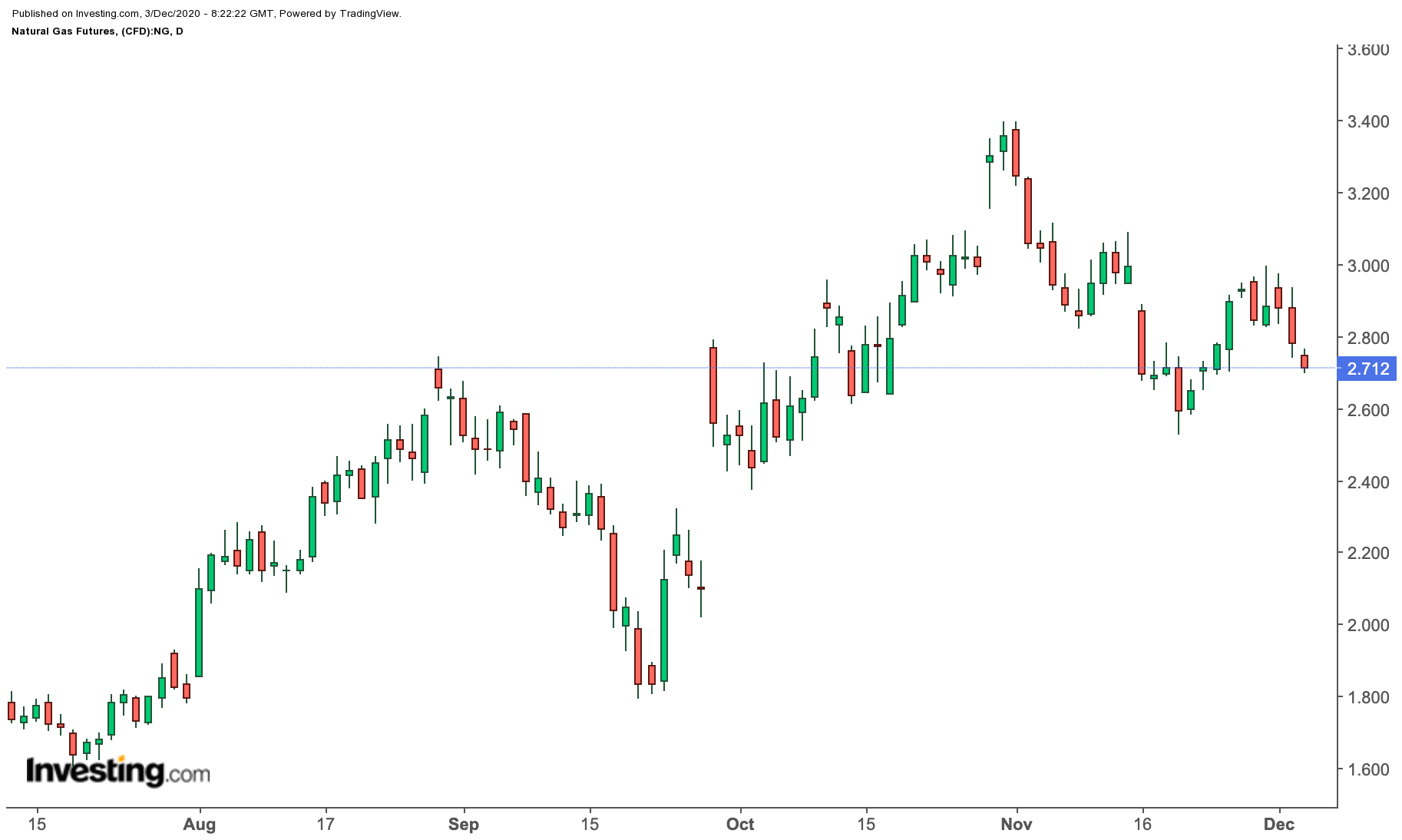Netflix, Broadcom and Carvana rise premarket; Warner Bros Discovery falls
Long-only investors in natural gas are yearning for a return of $3 pricing, as weather models suggest colder temperatures that may finally bring an end to the unseasonably warm winter that has obliterated demand for gas-driven heating.

Even so, gas bulls will probably have to contend with one more dismal heating data release from the Energy Information Administration today at 10:30 AM ET (15:30 GMT), before seeing better numbers in the weeks ahead.
According to a consensus of analysts’ estimates, the EIA’s gas storage report for the just-ended Thanksgiving week will likely show a draw of around 12 billion cubic feet from inventory, versus the previous week’s already insipid 18 bcf reduction.
Warmer-Than-Usual Thanksgiving Adds To Gas Bulls’ Consternation
Some research houses, like Gelber & Associates, had an even lower number for the week ended Nov. 27. Dan Myers, analyst at the Houston-based consultancy, wrote in a note to the firm’s clients:
“G&A estimates that as little as 9 Bcf of gas may have been taken out of storage last week, based on robust production, slightly lower LNG exports, and reduced demand due to the Thanksgiving holiday.”
Myers noted that the five-year average for gas pulls in November was 41 bcf. That puts last week’s draw at an unusually low level, even for the kind of lackluster winter seen so far this year. It raises a longer-term worry for him, he wrote:
“It reflects just how unusually mild last month ended up. Even with the turnaround in temperatures now occurring, it is not clear that colder than normal weather will be sustained, and the market has reason to be more and more confident that current storage surplus levels will be sufficient to carry it through the season.”
On the brighter side, over the past two days, domestic US gas demand, excluding exports, has been estimated at over 100 Bcf for the first time this winter, suggesting that intense cold might finally be breaking in, Myers said.
“This suggests that stronger storage withdrawals are in store for the market, with Gelber predicting a 104 Bcf withdrawal in next week’s report (due Dec. 10).”
The EIA report comes as benchmark US gas futures are down again on the week, posting a decline of more than 3% at the time of writing. Just last week, the front-month gas contract on New York’s Henry Hub posted a 7% return, after an 11% slump the previous week.
Since slipping beneath $3 per mmBtu, or million metric British thermal units, the front-month gas contract has been struggling to recapture that position, coming as high as $2.995 in Monday’s Asian and European trading ahead of New York’s open.
Colder Temperatures Have To Show Up—And Stay
Scott Shelton, energy futures broker at ICAP in Durham, North Carolina, said colder temperatures had to show up soon if Henry Hub prices were not to see another round of attrition. In a note issued Wednesday, Shelton said:
“NG remains a weather bet for the winter as usual and I think there is enough time left in winter to keep a risk premium on Q1, but we will need to see some colder temps soon or end March will be projected high enough to send H/J NG (up) rather quickly,” he said, referring to the March/April Henry Hub contracts by their symbols.
The March/April trade is one of the biggest in natural gas, denoting a play on where heating demand will likely be as winter officially ends and spring begins.
“The question remains on F/G and G/H on what kind of premium they should hold as the risk of deliverability issues should be on their highs,” said Shelton, referring to the Jan/Feb and Feb/March trades as well.
What exactly do weather models show?
According to naturalgasintel.com, temperatures are likely to remain cold enough for the next few nights over the Rockies and Plains as well.
“Warmer air was set to move back across the East before another cold front moves through this weekend,” the industry news portal said in a blog, citing projections by NatGasWeather.
The rest of the United States was expected to be “exceptionally comfortable” by early December standards, the forecaster said, essentially leaving the pattern for Dec. 4-12 not as cold as needed to move prices higher.
Bespoke Weather Services, meanwhile, said Wednesday morning there is potential for some stronger cold toward the middle of the month, at least in the central part of the country. The issue, the firm said, has been that any truly colder outlook has not progressed forward in the forecast, so far. Bespoke’s chief meteorologist Brian Lovern added:
“We do favor the colder risks at mid-month, with the issue being duration.”
Last week’s weather was warmer-than-usual, with 114 heating degree days (HDDs), compared with a 30-year normal of 143 HDDs for the period, data from Refinitiv showed.
HDDs, used to estimate demand to heat homes and business, measure the number of degrees a day's average temperature is below 65 degrees Fahrenheit (18 degrees Celsius).
